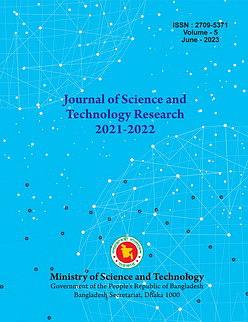Changes in Land Use and Land Cover, Normalized Difference Vegetation Index and Land Surface Temperature in the Narsingdi District During 2001 to 2021
DOI:
https://doi.org/10.3329/jscitr.v5i1.74012Keywords:
Heat Island, Land Surface Temperature (LST), Normalized Difference Vegetation Index (NDVI).Abstract
Rapid urbanization and industrialization cause land use changes, reduce green spaces, and increase the land surface temperature. Green spaces of a city area maintain environmental quality by absorbing air pollutants and reducing land surface temperature. The present study aimed to detect the changes in land use and land cover (LULC), normalized difference vegetation index (NDVI), and land surface temperature (LST) in the Narsingdi district including six Upazilas from 2001 to 2021. The Landsat 7- Enhanced Thematic Mapper Plus (ETM+), the Landsat 8- Operational Land Imager (OLI) imageries and the Moderate Resolution Imaging Spectroradiometer (MODIS) data were used to analyze the LULC, NDVI, and LST by using Google Earth Engine (GEE) and ArcGIS 10.8.2. The images were analyzed into four land use classifications – agricultural land, built-up area, forest vegetation, and water body. Among all the Upazilas, Narsingdi Sadar was the vulnerable area, where agricultural land, forest coverage, and water body decreased significantly by 6.67%, 2.2%, and 4.66%, respectively. The built-up area increased by a considerable amount of 13.53% during the last twenty years. The forest coverage of Narsingdi Sadar Upazila was calculated at only 8.91% in 2021 and decreased from 11.11% in 2001. The NDVI values surprisingly increased in all the Upazilas, but in Narsingdi Sadar, it is comparatively low (0.08) than in other Upazilas. The increasing trend in LST in the Narsingdi Sadar Upazila is alarming, 1.14oC from 2001 to 2021 (0.57oC/decade). The significant changes in LULC, NDVI, and LST made the Narsingdi Sadar a more critical area in the Narsingdi district. The findings of the study will be helpful to policymakers in making appropriate decisions in future city development.
J. of Sci. and Tech. Res. 5(1): 93-118, 2023
335
238
Downloads
Published
How to Cite
Issue
Section
License
Copyright (c) 2023 Md Danesh Miah, Mohammad Khorshed Ali, Md Rabin Miah, G N Tanjina Hasnat

This work is licensed under a Creative Commons Attribution 4.0 International License.




